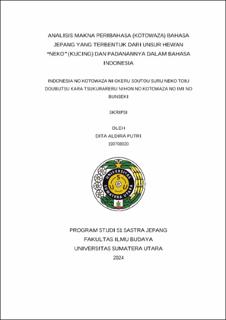Analisis Makna Peribahasa (Kotowaza) Bahasa Jepang yang Terbentuk dari Unsur Hewan “Neko” (Kucing) dan Padanannya dalam Bahasa Indonesia Indonesia No Kotowaza Ni Okeru Soutou Suru Neko Toiu Doubutsu Kara Tsukurareru Nihon No Kotowaza No Imi No Bunseki
Meaning Analysis of Japanese Proverbs (Kotowaza) Formed from the Animal Element "Neko" (Cat) and Their Indonesian Equivalents

Date
2024Author
Putri, Dita Aldira
Advisor(s)
Hasibuan, Adriana
Alimansyar
Metadata
Show full item recordAbstract
This study analyzes the meanings of Japanese proverbs (kotowaza) that feature the animal element “neko” (cat) and their equivalents in Indonesian proverbs. Semantics, a field of study focused on meaning, is the primary discipline examined in this research. Within semantics, the concepts of denotative and connotative meanings are central to the analysis. This study employs a mixed-method approach, combining qualitative descriptive analysis and quantitative analysis. The qualitative descriptive method is used to describe the forms and meanings of Japanese kotowaza that involve the “neko” (cat) element, as well as their counterparts in Indonesian proverbs. The quantitative method is applied to quantify the number of Japanese kotowaza and Indonesian proverbs that share equivalent meanings or structural components involving the “neko” (cat) element. The data sources include Kamus Peribahasa Bahasa Jepang, Koji Kotowaza no Jiten, the online resource nekojiten.com, and Kamus Peribahasa Indonesia. The analysis revealed 36 data points, consisting of 21 Japanese kotowaza and 15 Indonesian proverbs that involve the “neko” (cat) element. Among the 21 Japanese kotowaza, 6 were found to be equivalent to Indonesian proverbs in both structure and meaning, resulting in 12 equivalent proverbs. Additionally, 18 proverbs were identified as having similar denotative and connotative meanings, although their structural elements differed, such as involving body parts, nature, or animals other than cats. Furthermore, 6 Japanese kotowaza involving the “neko” (cat) element were found to have no equivalent meanings in Indonesian proverbs.
Collections
- Undergraduate Theses [593]
